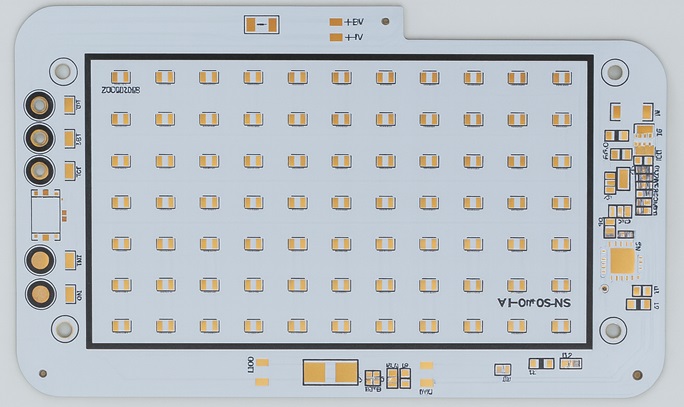Aluminum PCB circuit boards are PCBs with a metal core, typically made of aluminum rather than the traditional FR4 material. The metal core provides better thermal conductivity, resulting in more efficient heat dissipation. This makes aluminum PCBs ideal for high-power applications such as LED lighting, power electronics, and automotive applications.
Aluminum PCB Structure
Aluminum PCB circuit boards typically consist of four components: the top layer is a copper foil layer (ranging in thickness from 1 oz/35 µm to 10 oz/350 µm), which is used for circuit pattern etching, component mounting, and soldering. Beneath this is a dielectric layer (also known as a thermal insulation layer), often made of a ceramic-filled epoxy resin. This layer is both electrically insulating and highly thermally conductive, transferring heat from the copper layer to the aluminum base layer. The aluminum base layer in the middle serves as the primary heat sink and structural framework. It has a high thermal conductivity (approximately 150–180 W/m·K) and is typically 0.8–3 mm thick. It can be machined as needed to enhance heat dissipation. Some aluminum PCB circuit boards also have an aluminum oxide film formed on the aluminum base layer to enhance the dielectric layer's adhesion, electrical insulation, and overall durability.

aluminum pcb circuit board
Advantages of Aluminum PCBs
1. Environmental Protection
Aluminum is a highly recyclable and non-toxic material. Therefore, using metal for production helps conserve energy due to its ease of assembly. Therefore, when PCB suppliers use aluminum, they protect the environment.
2. Efficient Heat Dissipation
Aluminum pcb circuit boards feature an aluminum core, which provides excellent thermal conductivity and helps keep components on the PCB cool. This characteristic of aluminum PCBs facilitates the design of high-power LEDs or other switching MOSFETs, IGBTs, or SiCs in power supplies or automotive electronics.
3. High Durability
Aluminum is a durable material, making aluminum pcb circuit board highly resistant to wear and tear. They can withstand harsh environments, making them suitable for applications requiring high reliability and durability.
4. Lightweight
Compared to traditional FR4 PCBs, aluminum-core PCBs are lighter. This makes them ideal for applications where weight is a concern, such as the aerospace and automotive industries.
5. Cost-Effective
Aluminum PCBs are less expensive than FR4 materials because they are widely available and less susceptible to damage than other hard metals. Because aluminum PCBs themselves conduct heat, the overall manufacturing cost of the product is reduced.
Types of Aluminum PCBs
1. Standard single-layer aluminum PCBs: This is the most widely used aluminum pcb circuit board. The aluminum base layer is separated from the copper layer by a highly thermally conductive dielectric.
2. Double- or Multi-Layer Aluminum PCBs: These are double- or multi-layer PCBs bonded to an aluminum base. The dielectric layer requires high thermal conductivity.
3. Through-Hole Aluminum PCBs: As the name suggests, through-hole aluminum PCBs require pre-drilled holes, which are then filled with dielectric to prevent short circuits.
4. Flexible Aluminum PCBs: These boards utilize a flexible dielectric, providing electrical isolation and thermal conductivity. The combination of aluminum and dielectric materials creates a flexible PCB that can be customized. Their stack-up structure is similar, with this layer utilizing a polyamide (PI)-based material for enhanced insulation.
5. Hybrid Aluminum PCBs: These aluminum pcb circuit boards are used in radio frequency applications. If designed with standard FR4 products, their thermal performance is very high. High-frequency aluminum PCBs utilize polyolefin as the insulating material.
Applications of Aluminum PCBs
Aluminum PCBs have gained widespread acceptance in various lighting applications, including automotive lighting, LED applications, general lighting, and traffic signals. Furthermore, aluminum pcb circuit boards are often an ideal solution for tight tolerance and high-power devices.
1. LED Lighting: Most lighting applications utilize aluminum PCBs, such as LEDs for high-beam headlights, traffic signals, streetlights, operating room lighting, taillight tools, landscape lighting, interior lighting, and surgical lighting. These applications are possible due to their compatibility with power converter designs, automotive instrument clusters, power scanners, and power transmission circuits.
2. Automotive Equipment: One of the hidden advantages of using aluminum PCBs for switching circuits, power supplies, or high-current automotive equipment is the longevity of components due to their thermal stability.
3. Audio Equipment: Audio equipment also features aluminum PCBs with integrated inputs, outputs, and power amplifiers.
4. Communications Electronics: Communications electronics, bridge power modules, and solid-state relays that require heat sinks.
As electronic devices continue to evolve, becoming more powerful and smaller, the importance of efficient thermal management grows. Aluminum pcb circuit boards, with their superior heat dissipation capabilities and cost-effective price-performance ratio, will play a key role in shaping the future of electronic products across various industries.